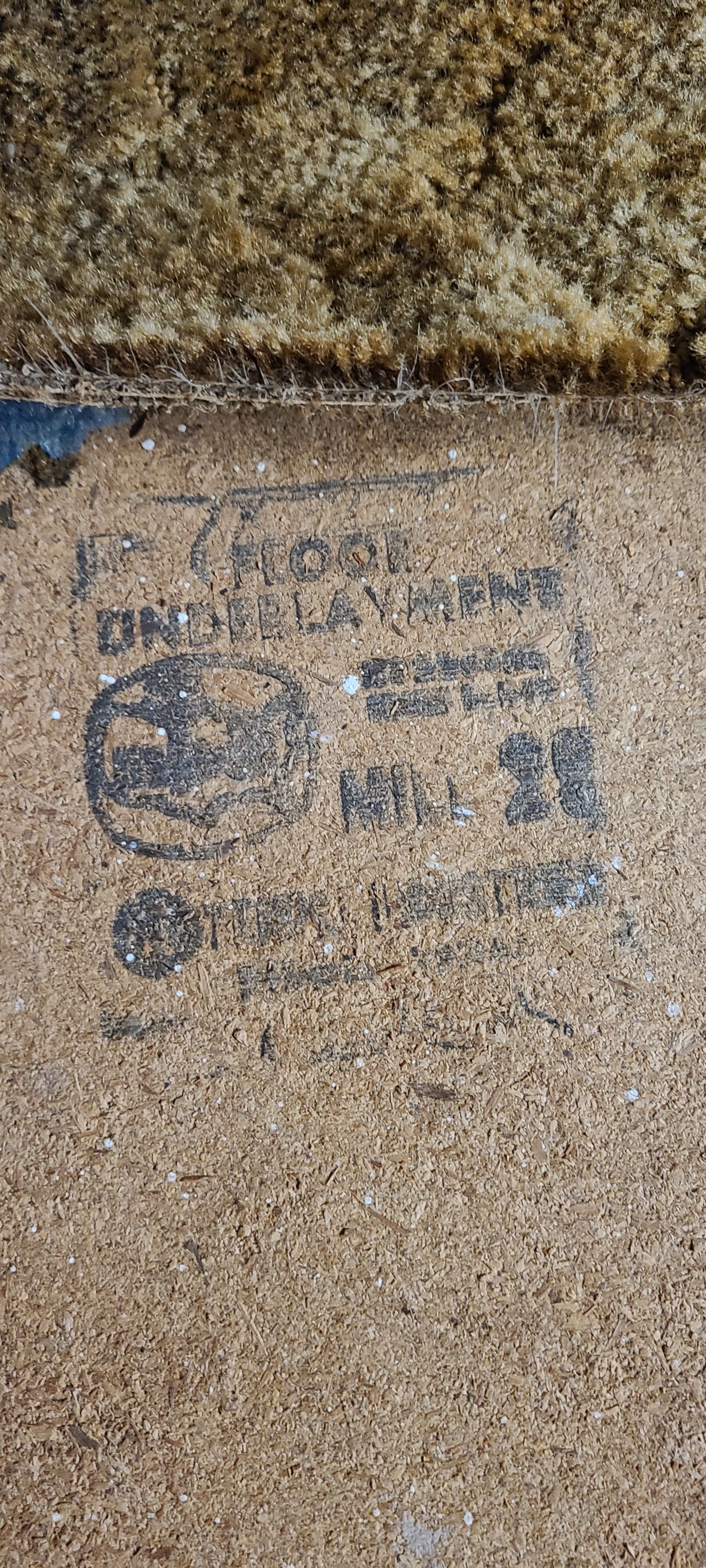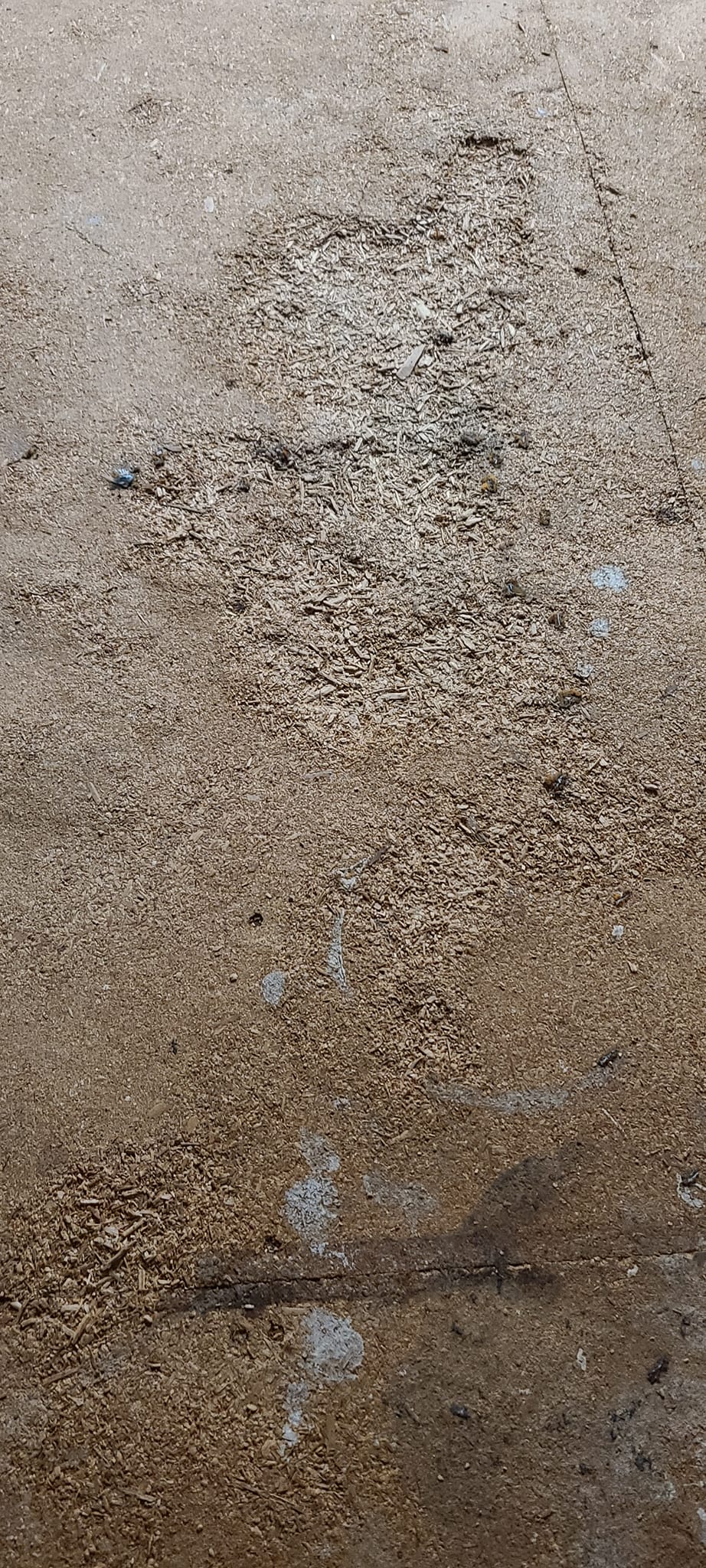How should I address water damage on subfloor before installing new flooring to avoid further issues?
In short, my house needs foundation work and the team will be coming on Monday to tackle that project (definitely above my skill level!) I’ve decided to replace the old, 40-year-old carpet with LVP after the foundation repair is done. As I started pulling up the baseboards and carpet, I found the subfloor, which was unexpected. It’s not wood, and I’m not sure what to do next. The area in the picture gets a lot of foot traffic from the front door and there’s water damage. I’ve also found a few smaller damaged spots from pulling up the tack strips. Should I try to level it out somehow? If so, what should I use to avoid causing more moisture damage? Or should I just cover it all with thin plywood? I have some experience with self-leveler, but I’ve never used it on MDF or particle board before. Any advice would be greatly appreciated! 😊


Is it currently wet? If not, I would try to keep it in place and cover it with underlayment. Removing MDF is a nightmare based on my experience.
Is just terrible to deal with, I had to remove it from 1800 sqft in my house. It really made me regret buying the house.
Yes, I agree!! I went through the same thing when my washing machine leaked. I went all the way down to the joist and basically started from scratch.
It’s dry now.
Typically that kind of material soaks up water really well. I suggest cutting out the wet area and going out another 12 inches. Replace it with the same thickness of osb. Then add luan and underlayment on top of everything. Best of luck 💪
Thanks a bunch!😊
They opt for using that board on trailer homes because it’s more affordable than plywood subfloor. It appears that you’ve had water problems that caused the MDF to crumble. If I were you, I’d remove all the MDF and replace it with 3/4″ thick tongue and groove plywood.
Oh yeah, those trailers. They use a bunch of low-quality materials like doors that are 6-4, ABS plastic pipes, plastic door handles, and funky cabinet hinges. Plus, the drywall is considered an upgrade.
Hey, this isn’t a mobile home. Most of it is still in good shape, with only a few small spots of damage like the one in the picture.
Maybe that was the case years ago lol. Nowadays, mobile homes are equipped with 3/4 t&g, 2×4 walls, truss roof rafters systems, LVP flooring, and granite countertops.
I always struggled trying to repair MDF. It has a tendency to soak up moisture (looking lumpy, for lack of a better word). I usually ended up removing it and replacing it with Luan or another subfloor material.
That’s particle board and should not be used as a subfloor. I recommend tearing it out and replacing it because it will deteriorate over time being mostly compressed sawdust.
Hey, FYI, MDF was commonly used as subfloor material in the 60s. It’s very typical to find it in new construction single family homes from that time.
Shared a frustrating experience with an old house he purchased from the 1800s. The material along the hallway over plank flooring was a nightmare to remove. It seemed like every inch was nailed down. After finishing, he ended up with a huge pile of the material in pieces. It’s unpleasant, absorbs odors, and degrades when exposed to moisture.
Agreed, she never claimed it was good, just that it was commonly used.
Hey, mentioned something negative.
That particle board is not a good choice for underlayment. If it gets wet, it can be a real disaster. Especially if you’ve added another layer of underlayment on top of it. I recommend removing it and putting down new underlayment before laying the LVP directly on top. Avoid using leveler as it can cause the material to swell. Your best options are to lay the LVP directly or to remove it all.
I’m curious about the flooring underlayment – does that mean there’s a subfloor underneath?
I totally agree. This underlayment seems pretty thin, so make sure to install it over a sturdy sub-floor. Check by removing a floor register to inspect the layers. Fingers crossed that it’s in good shape. If it is, use a circular saw to remove damaged MDF sections and replace them with new underlayment pieces.
You should consider improving the surface before installing the new flooring.
That’s exactly why I shared that 🙃
Replace the damaged parts and your floor will be good as new!
Place a level across the damaged mdf spots. If the pit is less than 1/8″, then I’d say go ahead and use LVP. If you’re going with a good brand that has rubber underlay attached to the plank, the imperfections won’t be noticeable. However, if it’s more than 1/8″, it’s best to just replace the compromised areas instead of redoing the entire subfloor.
The flooring is less than 1/8″ thick and it is LVP Stanton Timberland with a 5mm thickness and a 22mil wear layer. It comes with attached underlayment and I also bought extra rolled underlayment for added sound barrier. I wanted to make sure the investment would last before spending 5k on 400 sq ft of flooring. Thanks!
It’s wood. Just replace the worn-out section and opt for a higher grade LVP that is thick and padded. This will help smooth out any waviness and prevent it from separating too quickly.
Removing that stuff is a real pain. It breaks apart into tiny pieces and can really frustrate you. Personally, I’ve found that using a planer to get rid of the high spots from water damage works best. Then, I cover the entire floor with a generous layer of oil-based primer and fill in any deep holes with floor leveling material. To smooth out the self-leveling compound, I’ve had to use a diamond grinder head, which can create quite a mess. I noticed that harbor freight sells a grinder with a dust shroud and vacuum port, which would be a smart investment. Using an oil-based primer is key because it won’t penetrate the wood like a water-based primer would, sealing in any odors or other issues and preventing the MDF from absorbing the water from the leveling compound.
Clever idea!
I happen to be friends with the grandson of the person who invented that product. He wanted me to pass along his personal apologies for any inconvenience.
What’s up?
I enjoy saving money, that stuff is still good. I would vacuum up all the loose particles and then use Bondo to fill in the bad areas and sand them flat. After that, I would just prime everything to seal in any odors. If it’s in good condition, there’s no need to replace it.
I was thinking, would bondo be effective? Thanks!
I prefer to remove the damaged part whenever possible and replace it with a heavy wafer board or plywood, depending on my budget. Trying to level and repair the damaged area seems like a waste of time and money, as it requires different tools and skills. Plus, the remaining board is likely to be vulnerable to future damage.
I usually use an oscillating saw to cut along the line where the damage stops. Then, I grab a 6” scraper with a long metal handle and start prying! The nails usually come out quite easily. If the damage is severe, which it often is, the particle board will crumble around the nails. In such cases, a claw hammer comes in handy.
For a 3/8″ underlayment, it’s simple to remove and replace small sections. But if you opt to patch it up, keep in mind that standard floor levelers won’t work on particle board. You’ll need to use a solvent-based wood filler or a 2-part epoxy like Minwax Wood Filler, which sets quickly and can be sanded smooth in no time.
Excellent, is spot on!
Our house flooded and the main floor was a mess. I honestly want to rip it all out and replace it with plywood. It may be a bit costly, but if you’re already doing foundation work, the extra cost isn’t too bad. It’s a pain to remove, but I did it myself on 2100 sq ft and it wasn’t too terrible 🤷🏻♀️
We were advised to wait a year after fixing the foundation before replacing or redoing the floors. I suggest checking with them.
Use a skill saw to cross-cut it all with a demolition blade (don’t bother measuring). Adjust the depth to prevent cutting entirely through the MDF. A crowbar or similar tool will help remove most of the MDF. Let’s hope and pray they didn’t glue it down. Once most of it is removed, go back and extract the nails. If they used screws, they’re probably drywall screws and the heads will snap off. Use channel locks to remove the shafts. You can check if they unscrew easily, but I bet they’ll break.
As others have mentioned, it’s an absolute nightmare to remove, BUT you absolutely should remove it!!!
In my view, it’s best to get rid of it and opt for birch plywood. While you may cut costs with adhesives and dry-loc, the proper approach is to remove it. There’s no point in keeping water-damaged particle board.
From what I learned the hard way.. take it out and upgrade to actual plywood. I know it’s expensive upfront and a big project to undertake but it is definitely worth it in the long run.
I neglected to do so and had several individuals fall through my floors because of water damage.